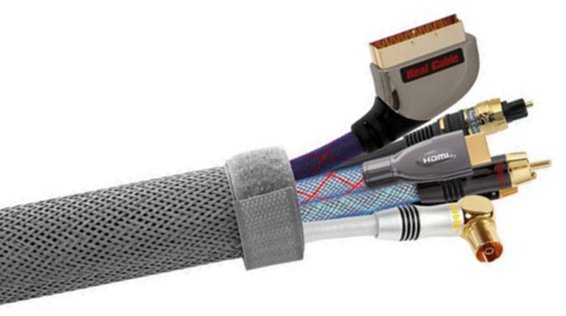|
Many people do the wiring for a home theater installation by first running a lot of conduit in walls, and then pulling cable in as needed. As often as not, this turns out rather badly. It's easy to underestimate the size of conduit required, and we have had countless calls from people who suddenly, at the peak of their installation work, need to pull a large amount of cable through an undersized conduit. If you're going to use conduit, we recommend installing the largest conduit your wall cavity will accommodate; 3/4 inch conduit will give you lots of grief unless your cabling needs are exceedingly modest.
The best use of conduit in most home theater installations is as a future-proofing device rather than as a primary means of installing cable. Rather than installing cable in conduit, consider installing cable and conduit. As long as you have access to the space where the conduit will go, it's generally easier to install the cable alongside, and the conduit then provides some assurance that, in the event that you need to run new types, or duplicate runs, of cable, you'll have a convenient way to get them in. If, however, you need to run conduit and then pull cable through it, there are a few tips that will make life easier: (1) Again: install the largest conduit your wall cavity will accommodate. If you're having this work done by an electrician, and he balks, assure him that this is what you want. Electricians rarely, in residential work, need to install large conduit, and are often skeptical of the need for it -- but they're usually not dealing with cables with limited pull strength, large dimensions, and pre-installed connectors. (2) Don't use bundled cables if you can avoid it. Cables like the "structured wiring" products found in home improvement stores, or the multi-coax bundles from Belden (e.g. 7710A) aren't flexible enough to be installed in conduit, especially if there are bends in the line. (3) When pulling cable, be sure to stagger connectors, so that there isn't one wide "blob" of connector bodies at the leading edge of the pull. (4) Always have someone able to "feed" the cable at the source as it's being pulled. Coaxial cables won't twist easily, and so it's important to be sure that they're being fed straight into the entry rather than, say, being left in a coil on the floor and being pulled through the conduit in a twisted fashion. Thanks for checking out this AVPro TECH Tip.
3 Comments
9/9/2021 01:59:48 am
Your article is very useful and good in writing so thanks for sharing your views .
Reply
4/2/2023 04:59:30 pm
Great blog post on the pros and cons of using conduit for cable management in AV installations! Your clear and concise explanation of the benefits of using conduit, such as increased protection and ease of future cable management, is incredibly helpful for those looking to optimize their AV setup. Additionally, your point about potential downsides, such as increased cost and installation time, shows a thorough consideration of all factors. Thank you for sharing your expertise and providing valuable insights to help improve AV installations.
Reply
5/30/2024 11:33:07 pm
Great tech tip! The debate between using conduit or not in home theater installation is one that many enthusiasts face. Your insights into the advantages and considerations of both options are invaluable for anyone planning their setup.
Reply
Leave a Reply. |
Third Party Reviews & Articles
SIX-G Generator
Archives
July 2024
Categories |
|
|
© Copyright 2015-2023
Home Contact Us About Us Careers Warranty 2222 E 52nd Street North, Suite 101, Sioux Falls SD 57104 +1 605-330-8491 [email protected] |


 RSS Feed
RSS Feed